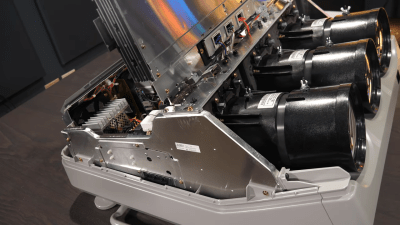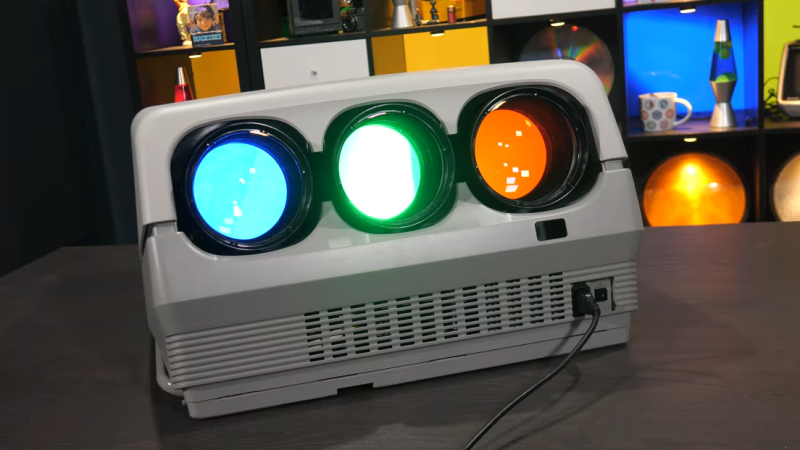CRT monitors: there’s nothing quite like ’em. But did you know that video projectors used to use CRTs? A trio of monochrome CRTs, in fact: one for each color; red, green, and blue. By their powers combined, these monsters were capable of fantastic resolution and image quality. Despite being nowhere near as bright as modern projectors, after being properly set up, [Technology Connections] says it’s still one of the best projected images he has seen outside of a movie theatre.

Still, these projectors had drawbacks. They were limited in brightness, of course. But they were also complex, labor-intensive beasts to set up and calibrate. On the other hand, at least they were heavy.
[Technology Connections] gives us a good look at the Sony VPH-D50HT Mark II CRT Projector in its tri-lobed, liquid-cooled glory. This model is a relic by today’s standards, but natively supports 1080i via component video input and even preserves image quality and resolution by reshaping the image in each CRT to perform things like keystone correction, thus compensating for projection angle right at the source. Being an analog device, there is no hint of screen door effect or any other digital artifact. The picture is just there, limited only by the specks of phosphor on the face of each tube.
Converging and calibrating three separate projectors really was a nontrivial undertaking. There are some similarities to the big screen rear-projection TVs of the 90s and early 2000s (which were then displaced by plasma and flat-panel LCD displays). Unlike enclosed rear-projection TVs, the screen for projectors was not fixed, which meant all that calibration needed to be done on-site. A walkthrough of what that process was like — done with the help of many test patterns and a remote control that is as monstrous as it is confusing — starts at 15:35 in the video below.
Like rear-projection TVs, these projectors were displaced by newer technologies that were lighter, brighter, and easier to use. Still, just like other CRT displays, there was nothing quite like them. And if you find esoteric projector technologies intriguing, we have a feeling you will love the Eidophor.
















Yes. I had one in my Home theatre room back in the day. my mom also had one in her place. They were a little bit of a pain to setup but once all was done and in the nice dark room it was grand for it’s time.
I used to work on rear projection TVs that used those same liquid-cooled lenses. Those things were fun to clean. The liquid would grow bacteria and I’d have to drain them, clean them, reassemble them and refill them. And good LORD did those things pack a punch. Working on one one day, I was doing some powered on tests. Of course I touched one of the high voltage leads. Shut the shop down and went home for that. That was enough of THAT for one day! Sigh… Fun times…
Sorry for laughing about it, somehow I saw in my head a South Park episode where Cartman was working at a projector ;). “gddamnit….. scrw you guys, im going home”
🤣 Yep… that was pretty much it!
I worked on the Barco and other projectors like the one featured, some of the stuff we worked on needed a source of constantly flowing cooling water and occasionbally a chiller to cool the lenses on the really big ones but damn they were scary, the tubes were not long lived and needed to be chaged often, the voltages involved demanded respect too.
The coolest application I’ve seen (and this was only in the past 10 years) was a fighter jet simulator with six Barco projectors throwing onto a kind of wrap around screen
They have had those fighter jet simulators for many years. I was asked to rebuild some way back in 2003. I do remember that there were 6 projectors per simulator, but not how many simulators. I think that was in Colorado. There are not many people that can do that kind of stuff anymore.
Tis many lost arts…. general repairing of things.. is a lost art… being able to get schematics and such….
The CAVE environments started from those systems, but quickly moved to more manageable, if lower resolution, per panel projectors. Usually they would be built out with 3 sides, two panels per side, and an overhead or two. Those panels were roughly 250K each in 2002, and could be taken out by a single dizzy guest who got an out of sync pair of glasses or the ultrasonic tracking glitched out.
ahh. the hell of adjusting the image in a mobile situation. and my back hurts when just thinking about them.
no i dont miss those times.
what about x rays exposure because those monsters can goes to 50 000 or more volts for brightness ?
The front face of the CRT is made of thick, leaded glass, which is effective at blocking most if not all of the X-rays produced
Are you just guessing? Because since they need to be extra bright and have the liquid in front that has a blocking effect I assume, and are not viewed face-on, I imagine the manufacturers would take all that into account and leaded glass might not be the thing they rely on.
Does glycol block radiation? Anybody know? (it was glycol they used right?)
The FDA (not, as you might expect, the FCC) has since 1968 maintained strict standards regarding the emission of harmful amounts of ionizing radiation (which includes x-rays), and those standards apply universally no matter how the device is viewed. A device that emits greater-than-negligible levels of x-rays would not be saleable in the US without special permits, monitoring, and warning labels.
I frequented a pub in the 80s that installed a projector like this. Glorious it was, for the time. It was huge. It was a showpiece. Transformative, even…
I don’t know if it was a deliberate management decision or just unintended consequences, but it immediately changed the whole character of the place.
Before, it was a roomful of tables with people being social and enjoying each others’ company. They’d have live music most nights, and rotating cast of regular customer.
After, the projector, screen and the throw distance took up the space of 2 or 3 tables, and the focus of the room was now THE SCREEN. The corner stage where the live performers played became mostly disused and storage for tables.
Now, when you went in, you couldn’t ignore THE SCREEN. Conversation was sparse, because everyone was watching, slack-jawed, at THE SCREEN. The focus of the place, the reason to go there, shifted to the content on THE SCREEN.
It didn’t take long for the clientele to change and business to drop off. They brought in a DJ to spice things up, with the projector showing psychedelic shows and music videos — MTV and MuchMusic had only been in existence a couple of years then, and were still novel. It didn’t help much. A few years later the place shuttered. Kind of sad to see that transformation.
I still wanted one of those projectors though. But now I have a DLP one that I can lift with one hand and outperforms those monsters in pretty much every respect. Ironically, it sees little use too because it, too, dominates the room.
Hated being on flights that had these, sucked when you were trying to sleep and the whole cabin was flashing. They are damned cool though.
I noticed a projector like this in an episode of the recent season of Severance. I immediately clocked how it would have worked but I assumed it was part of their alternate tech history thing. I didn’t realize any mad lads had actually done it this way, or that was kind of common.
In that episode the projector seems the be built into the room as permanent furniture, which makes a lot of sense after seeing Alec spend a day of his life setting one up
Having them built in was a very common way of dealing with both calibration and the size. I often saw them embedded into conference room ceilings
I, unfairly to the technology, have strong negative associations with these because they used to use them for in-flight entertainment on some of the larger airliners before LCDs became viable. A few seats with really odd sight lines might have normal CRTs in bulbs on the ceiling; but blocks of seats that could all see a projection screen would be served by one of these instead, lighter overall.
Tech worked fine; but I still can’t look at a CRT projector without the distinct sensation of having a seatback rammed into my kneecaps for 4+ hours; so we aren’t really friends.
I have a similar association with 16 mm film projectors. No kidding. On nearly decrepit Fokker F27s, in Zimbabwe.
Yes, I know they were common in the 60s and 70s, but that was before my flying days. By the 80s most airlines had moved on to CRTs. But not Zimbabwe…
Those Sony D50’s were small CRT projectors. 5 inch tubes. Sony also made a D70 (7 inch) and a D90 (9 inch). The D90 was pretty rare in North America. I think I only ever worked on 5 or 6 of them. The D70 was the most common of the three. Sony also made a series before the D series. VPH 12 I think. Its been too long. Then there were Barcos and Electrohomes and Mitsubishis and some crappy Zeniths. The Barcos had a lot of problems with power supplys. Mitsubishi was rare in North America. Electrohomes were the best IMHO. I worked on hundreds of them. The bigger ones were brighter. The Sony D series has limited convergence adjustment and I always had a problem getting all three colors in all four corners converged perfectly. The blue in one corner was always running out of adjustment before it lined up with the red and green. I always thought it was just my method of converging did not work all that well with Sony’s D series. Then I saw one set up at CES by some company that installed them for home theaters. They had the same problem. I guess it was not me.
There’s an AV shop in the Bay Area that bought out Sony’s remaining stock of the D50 and the G90 years ago, and is where I suspect Technology Connections got his. They still have a handful of each one, new in box, on ebay.
I used to love watching technology connections until he went all political and started ranting about the patriarchy, etc. I just don’t care about political identity garbage anymore.